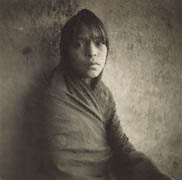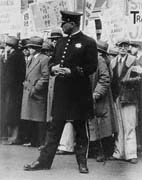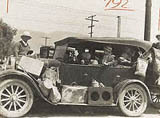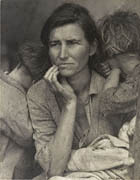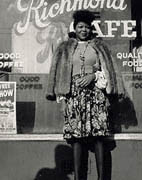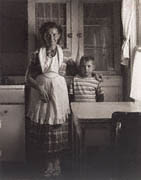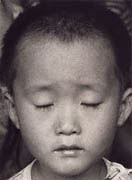Date |
This Moment in Lange's Life |
This Moment in U.S. History |
This Moment in Photography and Media History |
|
1881- |
|
1888 Eastman Kodak introduces the Kodak camera, the first portable hand-held camera. |
|
|
1890 The Progressive Era begins and continues through the 1920s. |
1890 Photographer Jacob Riis publishes How the Other Half Lives. |
||
|
1892 The Pledge of Allegiance is written. |
|||
|
1895 Born in Hoboken, NJ |
|
||
|
1897 First halftone process allows photographs to be published in newspapers and magazines. |
|||
|
1898 Spanish American War |
1898 The Great Train Robbery is first successful feature film. |
||
|
1901- |
1902 Contracts polio at age 7 and is left with lifelong limp from damaged leg and foot. |
1902 First transatlantic wireless telegraph message
sent. |
|
|
1903 Wright brothers fly the first successful airplane. |
|||
|
1904 Sociologist Lewis Hine begins to use a camera to document social issues as an instrument of social change. |
|||
|
1907 Her father abandons the family. Her mother begins working at the New York Public Library to support the family. |
1907 Edward Curtis begins to publish his photographic survey, The North American Indian. |
||
|
1908 Ford's first car, the Model-T, is produced. |
|||
|
1912 Massachusetts is first state to adopt a minimum wage requirement. |
|||
|
1913 Graduates from high school and decides to become a photographer. |
1913 The Armory Show in New York. This early exhibition of modern European art did not include photography. |
||
|
1914- |
1914 World War I begins |
||
|
1918 Moves to San Francisco and sets up a portrait studio. |
1918 World War I ends. |
||
|
1919 Prohibition begins. |
1919 Albert Einstein lectures on his Theory of Relativity at Columbia University in New York. |
||
|
1921- |
1920 19th Amendment to the Constitution ratified. Women are given the right to vote. |
1920 Photographers begin to experiment with photomontage
and photo-collage. |
|
|
1920 First commercial radio station, KDKA, opens in Pittsburgh. |
|||
|
1923 Accompanies husband Dixon to southwest Native American reservations. |
|
||
|
1924 U.S. Immigration bill passed, excluding all immigrants
from Japan. |
1924 Introduction of mass-produced, 35mm Ermanox and Leica cameras. |
||
|
1925 May 15: first son, Daniel Rhodes Dixon, is born. |
1925 The flashbulb is invented. |
||
|
1927 First demonstration of television. An image
was transmitted from Maryland to Washington DC. |
|||
|
1928 June 12: second son, John Eaglefeather Dixon is born. |
|
1928 Rolleiflex twin-lens reflex camera is introduced. |
|
|
1929 Herbert Hoover becomes president. |
1929 Museum of Modern Art (MOMA) opens in New York. |
||
|
1931- |
1930 Droughts in the American Midwest and Great Plains precipitate the Dust Bowl. |
1930 In the early 1930s the word "documentary"
is first used to describe films that portray real life, in
contrast to the world portrayed in the films of Hollywood. |
|
|
1931 Lindberg baby kidnapped. |
|||
|
1932 Franklin Delano Roosevelt (FDR) is elected President on his "New Deal" campaign. |
1932 Photoelectric cell light meter is introduced. |
||
|
1933 Begins to photograph victims of the Depression
in San Francisco. |
1933 Prohibition is repealed. |
1933 First color roll film is manufactured in U.S. |
|
|
1934 Has her first exhibition in Oakland, CA and meets
future husband, economist Paul Taylor. |
|||
|
1935 Paul Taylor becomes director of the California
Rural Rehabilitation Administration and hires Lange to work
with him. |
1935 Thousands of Great Plains farmers, known as "Okies,"
move west to California in search of work. |
1935 Dorothea Lange, Walker Evans, Arthur Rothstein, and others are hired by the RA (later the FSA) to take photographs that support the government's relief programs and publicize the plight of rural Americans. |
|
|
1936 Continues work for RA and FSA. |
1936 FDR re-elected to second term as U.S. president. |
1936 The first issue of Life, a picture
magazine, features a photograph by Margaret Bourke-White
on the cover. |
|
|
1937 Continues work for FSA. |
|
1937 Look picture magazine begins publication. |
|
|
1938 Continues work for FSA. |
1938 Photographs by FSA photographers are included in a MOMA exhibition. |
||
|
1939 An American Exodus published: an
assemblage of photographs by Lange and text by Paul Taylor. |
1939 Germany declares war on France and Britain. World War II begins. |
1939 John Steinbeck's novel The Grapes of Wrath,
based on firsthand interviews with migrant workers, is published. |
|
|
1941- |
1940 Begins to suffer from various
illnesses, including stomach ulcers. |
1940 FDR elected to a third term as U.S. president. |
1940 The government's Office of War Information (OWI)
declares that movies are essential to morale and propaganda. |
|
1941 Awarded Guggenheim Foundation fellowship. |
1941 Dec 7: Japan bombs Pearl Harbor. The U.S. enters World War II, ending the Depression. |
1941 Let Us Now Praise Famous Men is published. Documenting the lives of Southern Tenant farmers, it included a photoessay by Walker Evans. |
|
|
1942 Through 1945: works for the Office of War Information
(OWI). |
1942 FSA transferred into the Office of War Information
(OWI). |
|
|
|
1943 Los Angeles "Zoot Suit" and Detroit race riots. |
|||
|
1944 December - Germany surrenders. World War II continues with the battle in the Pacific against Japan. |
|||
|
1945 Through 1951: Lange ceases taking photographs for several years while she takes care of her health. |
1945 April: FDR dies. Vice President Harry
Truman assumes the presidency. |
1945 First digital computer completed, ENIAC (Electronic Numerical Integrator and Computer). Originally used to determine bomb trajectories. 20 human hours of calculations took ENIAC only 30 seconds. |
|
|
|
1947 House Un-American Activities Committee (HUAC)
hearings begin: otherwise known as the "McCarthy
Trials." |
1947 Commercial television is made available to the
public. |
|
|
1948 Mohatmas Ghandi assassinated. |
1948 Polaroid film and camera introduced. |
||
|
1949 North Atlantic Treaty Organization (NATO) established. |
1949 Contax S Camera introduced. The first single-lens camera with a pentaprism that corrects the previously upside-down, reversed image seen through the lens. |
||
|
1951- |
1950 Korean war begins. |
1950 The Xerox machine is invented. |
|
|
1951 Begins to photograph again after prolonged illness. |
1951 Color TV invented. |
||
|
1952 Founds Aperture magazine with Ansel Adams, Minor White, Barbara Morgan, and Beaumont and Nancy Newhall. |
1952 U.S. tests the first H-bomb at Los Alamos, NM. |
|
|
|
1953 Works on an essay with Ansel Adams, "Three Mormon Towns," published in Life magazine in 1954. |
1953 Korean War ends. |
1953 Kinsey report on sexuality is published. |
|
|
1954 Goes to Ireland on assignment for Life magazine. The photo-essay,"Irish Country People," is published in 1955. |
1954 McCarthy Hearings are televised: investigations
by HUAC into alleged Communists in the army. |
1954 Elvis releases his first singles on Sun records. |
|
|
1955 Begins work on a photo-essay documenting the
daily life of a public defender in Oakland, CA. |
1955 Rosa Parks refuses to give up her seat on a public
bus in Montgomery, Alabama. |
1955 The Family of Man, an exhibition of photography, opens at MOMA. The catalogue is on the bestseller list that year. |
|
|
1956 Dr. Jonas Salk develops a vaccine for polio. |
||
|
1957 Sputnik 1 and 2 (the first satellites to orbit the earth) launched by the USSR. The Space Race begins. |
1957 Jack Kerouac publishes On the Road. |
||
|
1958 Travels extensively throughout Asia with husband, Paul Taylor. |
|||
|
1959 The Barbie Doll is introduced by Mattel. |
|||
|
1960 Travels to South America with Taylor. |
1960 John F. Kennedy elected as U.S. President. |
1960 The birth control Pill is approved by the FDA and made available to the public. |
|
|
1961 Let Us Now Praise Famous Men is republished and sparks a renewed interest in documentary photography. |
|||
|
1962 Spends much of the year in a hospital but is well enough to travel to Egypt with Taylor in December. |
1962 Cuban Missile Crisis. |
||
|
1963 The Vietnam conflict escalates as the U.S. becomes
deeply involved in the war against the Communist government
of North Vietnam. |
1963 Betty Friedan's The Feminine Mystique
is published. |
||
|
1964 Begins to assemble material for a major retrospective of her work to open in January 1966 at MOMA. |
1964 President Lyndon Johnson proclaims his intention to build a "Great Society." |
1964 The Beatles have their first hit in the U.S. |
|
|
1965 October 11: Dies of cancer of the esophagus in San Francisco. |
1965 Watts race riots in Los Angeles. |
||
|
1966 MOMA retrospective of Lange's work opens in January. |
1966 NOW (National Organization of Women) is founded. |
||
|
1967 Tom Wolfe publishes The Electric Kool-Aid Acid Test. |
|||
|
1968 Martin Luther King is assassinated. |
1968 The Graduate, a film starring Dustin Hoffman,
is released. |
||
|
1969 Neil Armstrong is the first man to walk on the moon. |
1969 The Woodstock Music and Arts Fair is held on a farm in upstate New York. |
||

